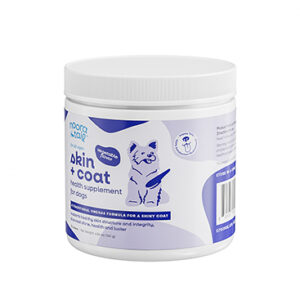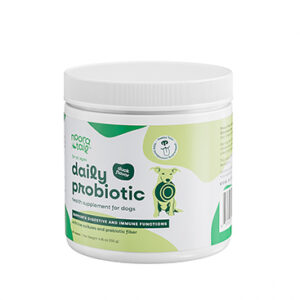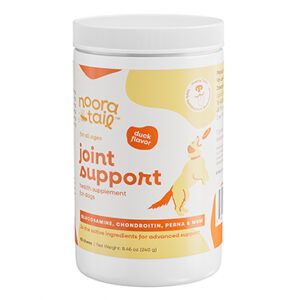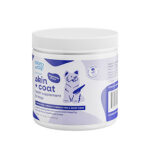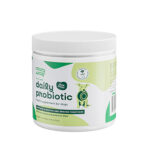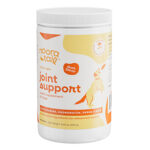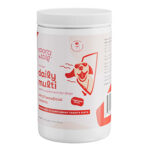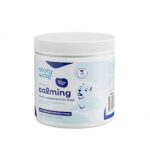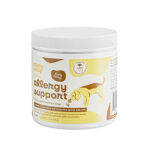Easy Dog Treat Outline

Introduction
Indulge your furry soulmate with homemade dog treats that are not only delicious but also packed with nutrition and love. With these easy-to-follow recipes, you can create mouthwatering snacks that will make your pooch’s tail wag with joy.
Basic Ingredients for Dog Treats
Most dog treats require a few staple ingredients:
- Whole wheat flour: The base of many treats, providing carbohydrates for energy.
- Coconut flour or oat flour: Alternative flours for dogs with grain sensitivities.
- Peanut butter: A canine favorite, high in protein and healthy fats.
- Bananas: Rich in potassium and fiber, adding sweetness and moisture.
- Pumpkin puree: A digestive aid, also providing vitamins and minerals.
- Yogurt: A source of probiotics, supporting gut health.
Easy Dog Treat Recipes
1. Peanut Butter Banana Bites
- 1/2 cup whole wheat flour
- 1/2 cup peanut butter
- 1/2 ripe banana
Mix all ingredients in a bowl until a dough forms. Roll out the dough and cut into bite-sized pieces. Bake at 350°F (175°C) for 10-12 minutes.
2. Pumpkin Pupsicles
- 1/2 cup pumpkin puree
- 1/2 cup yogurt
- 1/4 cup water
Combine the ingredients in a food processor until smooth. Pour the mixture into popsicle molds and freeze for at least 4 hours.
3. Oatmeal Apple Delights
- 1 cup oat flour
- 1/2 cup applesauce
- 1/4 cup peanut butter
Combine all ingredients in a bowl and mix until a dough forms. Roll out the dough and cut into shapes with cookie cutters. Bake at 300°F (150°C) for 15-20 minutes.
4. Sweet Potato Chews
- 1 large sweet potato
- 1/4 cup coconut flour
- 1/4 cup olive oil
Preheat oven to 350°F (175°C). Pierce the sweet potato with a fork and microwave for 10 minutes, or until tender. Mash the sweet potato and mix with the coconut flour and olive oil. Spread the mixture thinly onto a greased baking sheet and bake for 30-45 minutes, or until crispy.
5. Doggy Donuts
- 1 cup whole wheat flour
- 1/2 cup peanut butter
- 1/2 cup yogurt
- 1/4 cup honey
Mix all ingredients in a bowl until a dough forms. Roll out the dough and cut out donuts with a donut cutter. Bake at 350°F (175°C) for 10-12 minutes.
Tips for Making Dog Treats
- Use unsalted, natural peanut butter without xylitol, which is toxic to dogs.
- Limit treats to 10% of your dog’s daily caloric intake.
- Store treats in an airtight container at room temperature for up to 2 weeks, or freeze for longer storage.
- Monitor your dog for any allergic reactions.
Conclusion
With these easy dog treat recipes, you can spoil your furry friend with homemade treats that are both nutritious and delicious. Experiment with different flavors and ingredients to create your dog’s favorite snacks. Remember to follow the serving guidelines and consult with your veterinarian if you have any concerns about your dog’s diet. Happy baking and enjoy the wag-worthy smiles!
Ingredients:

As a dog pet blogger, I am always on the lookout for delicious and healthy treats to spoil my canine companion. Over the years, I have experimented with various recipes, and I have discovered that homemade treats are not only easy to make but also packed with flavor and nutrients that my dog loves.
In this article, I will share my favorite dog treat recipe that is simple to follow and requires only a few basic ingredients. Let’s get baking!
Ingredients:
Flour:
- 2 cups whole wheat flour
- 1/2 cup coconut flour
Meat:
- 1 pound ground chicken or turkey
- 1/2 pound cooked salmon or tuna
Additional Flavorings and Supplements:
- 1/4 cup grated carrots or sweet potato
- 1/4 cup chopped parsley or basil
- 1 tablespoon olive oil
- 1 teaspoon baking soda
Instructions:
- Preheat the oven: Preheat your oven to 350 degrees Fahrenheit. Line a baking sheet with parchment paper.
- Combine the dry ingredients: In a large bowl, whisk together the whole wheat flour and coconut flour.
- Add the meat: Add the ground chicken or turkey to the flour mixture and use your hands to mix until well combined.
- Incorporate the cooked fish: Break up the cooked salmon or tuna into small pieces and add to the bowl. Mix well.
- Add the additional flavorings: Stir in the grated carrots or sweet potato, chopped parsley or basil, olive oil, and baking soda.
- Form the dough: Use your hands to form the dough into small balls or any desired shape. Place the treats on the prepared baking sheet.
- Bake: Bake the treats for 20-25 minutes, or until they are golden brown.
- Let cool: Remove the treats from the oven and let them cool completely before giving them to your dog.
Storage:
Store the homemade dog treats in an airtight container in the refrigerator for up to 3 days. Alternatively, you can store them in the freezer for up to 2 months.
Benefits:
These homemade dog treats are not only delicious but also provide your furry friend with a range of health benefits:
- Whole wheat flour: Rich in fiber, vitamins, and minerals
- Coconut flour: High in protein, fiber, and healthy fats
- Ground chicken or turkey: Lean protein source essential for muscle development
- Cooked salmon or tuna: Excellent source of omega-3 fatty acids for healthy skin and coat
- Vegetables: Provide antioxidants and vitamins for overall health
- Baking soda: Neutralizes acids and makes the treats more digestible
Tips:
- You can substitute other types of meat, such as beef or pork, in this recipe.
- Add a dash of salt or garlic powder to the dough for extra flavor (optional).
- You can use cookie cutters to create fun shapes for the treats.
- These treats are also suitable for puppies, but monitor their intake to ensure they don’t overeat.
Conclusion:
Making homemade dog treats is a rewarding and fun activity that allows you to provide your beloved pet with healthy and delicious snacks. The recipe shared in this article is easy to follow, requires only a few simple ingredients, and yields treats that your dog will absolutely love. Spoil your furry companion with these homemade delights and watch them wag their tail with joy!
Preparation:

As a dog owner, providing your furry friend with healthy and appetizing treats is a top priority. Homemade treats not only satisfy their taste buds but also offer peace of mind knowing exactly what ingredients go into their bodies. Here’s a step-by-step guide to preparing delicious and easy dog treats:
Ingredients:
- 2 cups whole wheat flour
- 1/2 cup rolled oats
- 1/2 cup water
- 2 tablespoons peanut butter (unsalted and unsweetened)
- 1 tablespoon honey
- 1 egg (optional)
Preparation:
1. Measure and Mix:
- Gather all the ingredients and measure them accurately using a measuring cup and spoons.
- In a large bowl, whisk together the whole wheat flour and rolled oats.
2. Combine Wet Ingredients:
- In a separate bowl, combine the water, peanut butter, honey, and egg (if using). Mix until a smooth paste is formed.
3. Form the Dough:
- Gradually add the wet ingredients to the dry ingredients, mixing with a spoon or spatula.
- Knead the dough on a lightly floured surface until it becomes smooth and elastic. Avoid over-kneading.
4. Roll Out the Dough:
- Sprinkle a little flour on a clean work surface.
- Roll out the dough to a thickness of about 1/4 inch.
5. Cut Out Shapes:
- Use cookie cutters or a knife to cut out desired shapes from the dough. You can create bone-shaped treats, stars, hearts, or any other fun design.
6. Bake:
- Preheat your oven to 350 degrees Fahrenheit (175 degrees Celsius).
- Line a baking sheet with parchment paper.
- Place the cut-out treats on the prepared baking sheet.
- Bake for 10-12 minutes, or until the edges are lightly golden brown.
7. Allow to Cool:
- Remove the treats from the oven and let them cool completely on a wire rack.
Tips:
- For a chewier treat, bake for an additional 5 minutes.
- You can add other healthy ingredients to your treats, such as grated carrots, apples, or flaxseed.
- Store the treats in an airtight container at room temperature for up to 5 days.
- These treats are not suitable for puppies under 12 weeks old.
Benefits of Homemade Dog Treats:
- Control over Ingredients: You know exactly what goes into your dog’s treats, ensuring their health and well-being.
- Customized Nutrition: You can tailor the treats to meet your dog’s specific dietary needs or allergies.
- Bonding Experience: Preparing homemade treats together can be a fun and rewarding activity for you and your furry friend.
- Cost-Effective: Homemade treats are much more budget-friendly than store-bought treats.
Conclusion:
Creating homemade dog treats is a simple and fulfilling way to show your canine companion how much you care. With this easy recipe and the tips provided, you can whip up delicious and nutritious treats that will keep your furry friend happy and satisfied. Remember, always consult with your veterinarian if you have any concerns about your dog’s diet or allergies.
Cooling and Storage:
As a devoted pet blogger, sharing tantalizing dog treat recipes is an integral part of your mission. To ensure your furry readers savor every bite, it’s crucial to provide them with guidance on how to properly cool and store these culinary delights.
Cooling After Baking
- Allow to cool completely: Once the treats come out of the oven, let them rest on a wire rack for at least 30 minutes, or until they have completely cooled. This allows the heat to dissipate gradually, preventing the treats from becoming soggy or losing their crispy texture.
- Cool in refrigerator (optional): For faster cooling, you can transfer the treats to a refrigerator for about 10-15 minutes. However, avoid prolonged refrigeration, as this can dry them out.
Storing Properly
Airtight Containers:
- Place the cooled treats in airtight containers to prevent moisture and air from entering. This will prolong their shelf life and preserve their freshness.
- Glass jars with tight-fitting lids or BPA-free plastic containers are excellent options for this purpose.
Temperature Control:
- Store the treats in a cool, dry place away from direct sunlight. The ideal temperature range is between 50-60°F (10-16°C).
- Avoid storing them in warm areas, such as near a stove or oven, as this can accelerate their spoilage.
Refrigeration:
- For treats containing perishable ingredients (e.g., meat, dairy), refrigeration is essential. Store these treats in the refrigerator for up to 3-5 days.
- Defrost completely before serving to ensure their texture and flavor remain intact.
Freezer Storage:
- If you want to extend the shelf life of your treats even further, you can freeze them. Freeze the treats in individual portions or in an airtight container for up to 2-3 months.
- Thaw completely at room temperature before serving.
Other Tips:
- Use a food sealer: For optimal freshness, consider using a vacuum food sealer to remove air from the storage container.
- Avoid overcrowding: When storing treats in containers, ensure they have enough space to prevent crushing.
- Check for spoilage: Regularly inspect your stored treats for any signs of spoilage, such as mold or an unpleasant odor. Discard any spoiled treats immediately.
By following these cooling and storage guidelines, you can help your readers ensure that their homemade dog treats remain fresh and delectable, providing their furry companions with a treat that will delight their taste buds and nourish their well-being.
Nutritional Value:
Introduction
As dog parents, we all want to give our precious companions the best nutrition possible. Treats are an essential part of any dog’s diet, providing not only momentary joy but also nutritional benefits. However, not all dog treats are created equal. Some are packed with unhealthy ingredients that can do more harm than good. That’s why it’s crucial to choose treats that are not only delicious but also nutritiously sound.
In this article, we’ll delve into the nutritional value of easy dog treats, exploring the essential nutrients they provide and their importance for your dog’s overall health and well-being.
Nutritional Components
Easy dog treats typically contain three macronutrients: protein, carbohydrates, and fat. Each nutrient plays a vital role in your dog’s diet.
-
Protein: Protein is the building block of all cells in your dog’s body. It’s essential for muscle development, tissue repair, and immune function. Treats high in protein help keep your dog feeling full and satisfied.
-
Carbohydrates: Carbohydrates provide energy for your dog’s daily activities. However, not all carbohydrates are created equal. Complex carbohydrates, found in whole grains and vegetables, are slowly digested and provide sustained energy.
-
Fat: Fat is an important source of energy for dogs and helps them absorb vitamins and minerals. Healthy fats, found in fish, avocados, and coconut oil, can support skin and coat health and reduce inflammation.
The Perfect Balance
The ideal nutritional balance of dog treats varies depending on your dog’s age, weight, and activity level. However, a good starting point is to choose treats that contain:
- 30-50% protein: for muscle building and maintenance
- 25-40% carbohydrates: for energy
- 10-20% fat: for energy and nutrient absorption
Additional Nutrients
In addition to macronutrients, easy dog treats can also contain other important nutrients that support your dog’s health, including:
- Fiber: Fiber aids in digestion and helps keep your dog feeling full.
- Vitamins: Vitamins A, C, and E are essential for immune function, vision, and coat health.
- Minerals: Minerals such as calcium, phosphorus, and iron are crucial for bone strength and overall well-being.
Benefits of Nutritious Dog Treats
Feeding your dog nutritious treats has numerous benefits, including:
- Maintaining a healthy weight: Treats that are low in calories and fat can help prevent weight gain.
- Promoting dental health: Some treats contain enzymes that help clean teeth and reduce plaque buildup.
- Rewarding good behavior: Treats can be used as a positive reinforcement tool to encourage desired behaviors.
- Providing mental stimulation: Treats can be hidden in toys or used for interactive training sessions, stimulating your dog’s mind.
- Strengthening the bond between you and your dog: Sharing treats with your dog is a bonding experience that fosters a strong relationship.
Conclusion
Easy dog treats can be a valuable addition to your dog’s diet when chosen wisely. By opting for treats with a balanced nutritional profile, you can provide your furry friend with the essential nutrients they need to thrive. Remember to choose treats that are appropriate for your dog’s individual needs and consult with your veterinarian before making any significant dietary changes. With a little research, you can find easy dog treats that are both delicious and nutritious, ensuring your beloved companion lives a long, healthy, and happy life.
Customizations:
As devoted dog parents, we all strive to provide our furry companions with the best possible care, including a healthy and nutritious diet. While store-bought dog treats can be convenient, homemade treats allow us to control the ingredients and customize them to meet our dogs’ specific dietary needs and preferences.
Benefits of Homemade Dog Treats
- Superior Ingredients: Homemade treats use fresh, wholesome ingredients, ensuring your dog gets the nutrients they need without harmful preservatives or additives.
- Dietary Control: You can tailor treats to accommodate dietary restrictions, such as allergies, sensitivities, or digestive issues.
- Bonding Activity: Preparing homemade treats together can be a fun and enriching bonding experience for you and your dog.
- Cost-Effective: Homemade treats are generally more economical than store-bought options, especially when made in bulk.
DIY Treat Recipes for Every Occasion
Here are a few easy-to-follow recipes for homemade dog treats that cater to a variety of tastes and needs:
1. Basic Bone Biscuits
- 2 cups whole wheat flour
- 1 cup chicken broth
- 1/2 cup peanut butter (unsweetened and no xylitol)
Instructions: Mix all ingredients in a bowl. Form dough and roll out on a floured surface. Cut into bone shapes and bake at 350°F for 15-20 minutes.
2. Pumpkin Pupcakes
- 1 cup canned pumpkin
- 1/2 cup unsweetened applesauce
- 1 egg
- 1/2 cup whole wheat flour
Instructions: Preheat oven to 350°F. Line a muffin tin with paper liners. Mix ingredients in a bowl and fill liners. Bake for 20-25 minutes or until set.
3. Sweet Potato Chews
- 1 large sweet potato, cooked and mashed
- 1 egg yolk
- 1/4 cup whole wheat flour
Instructions: Combine ingredients in a bowl. Form dough and roll out on a floured surface. Cut into desired shapes and bake at 375°F for 15-20 minutes.
Customizing Your Treats
The beauty of homemade dog treats lies in their versatility. You can customize them to suit your dog’s unique needs and preferences by:
- Varying Meats: Use different meats (e.g., chicken, beef, turkey) to provide variety.
- Adding Vegetables: Finely chop vegetables like carrots, spinach, or zucchini to boost nutritional value.
- Adjusting Flavors: Incorporate herbs like rosemary, basil, or parsley for flavor and health benefits.
- Matching Dietary Needs: If your dog has allergies or sensitivities, substitute ingredients accordingly (e.g., use oat flour for gluten-sensitive dogs).
- Adding Supplements: Consult with your veterinarian about adding vitamins or supplements to enhance the treats’ nutritional value.
Conclusion
Homemade dog treats are a simple and rewarding way to express our love and care for our canine companions. By customizing these treats to their specific dietary needs and preferences, we can ensure they enjoy healthy, delicious snacks that support their well-being. So, get creative and start baking today! Your furry friend will thank you for it with a wagging tail and a joyful bark.
Safety Precautions:
As a dog owner, you want to provide your beloved companion with the best possible care, including nutritious and delectable treats. While homemade dog treats can be a fun and rewarding endeavor, it’s crucial to prioritize the safety of your furry friend by adhering to proper handling and storage practices.
Importance of Safe Treat Handling
Just like human food, dog treats can spoil if not handled and stored properly. Spoiled treats can harbor bacteria that can cause gastrointestinal distress, vomiting, and diarrhea in your dog. Additionally, treats that have been contaminated with pathogens, such as mold or E. coli, can lead to more severe health issues.
Proper Handling
- Wash Your Hands: Always wash your hands thoroughly with soap and water before handling dog treats. This helps prevent the transfer of bacteria from your skin to the treats.
- Avoid Raw Meat: While some raw meat treats, such as beef or chicken, can be beneficial for dogs, they must be handled with extreme care to prevent contamination. Consider purchasing pre-packaged raw meat treats or freeze-drying your homemade versions.
- Use Clean Utensils: When preparing homemade treats, always use clean utensils and equipment. This includes measuring cups, mixing bowls, and spatulas.
- Limit Handling: Avoid excessive handling of treats to minimize the risk of introducing bacteria.
Proper Storage
- Airtight Containers: Store dog treats in airtight containers to prevent moisture buildup and the entry of pests. Glass or food-grade plastic containers are ideal.
- Cool and Dry Location: Choose a cool and dry location for storing dog treats. Avoid placing treats near heat sources, such as ovens or stoves.
- Refrigeration: Some treats, such as those containing meat or dairy, may require refrigeration. Check the manufacturer’s recommendations or use your best judgment.
- Discard Spoiled Treats: If you notice any signs of spoilage, such as mold or an off odor, discard the treats immediately. Do not feed them to your dog.
Additional Safety Measures
- Moderation is Key: As with all treats, moderation is essential. Offer treats in small amounts and as part of a balanced diet to prevent weight gain and digestive issues.
- Avoid Human Treats: Many human treats, such as chocolate and grapes, are toxic to dogs. Stick to treats specifically formulated for canine consumption.
- Monitor Your Dog: After giving your dog a treat, observe them for any signs of discomfort or allergic reactions. If you notice any unusual symptoms, contact your veterinarian immediately.
Benefits of Homemade Dog Treats
While safety is paramount, homemade dog treats can offer several benefits:
- Customized Nutrition: You can tailor homemade treats to meet your dog’s specific nutritional needs, such as choosing ingredients that support joint health or sensitive stomachs.
- Bonding Experience: Preparing dog treats together can be a fun and bonding experience for you and your furry friend.
- Cost-Effective: Homemade treats can be more cost-effective than store-bought treats, especially if you use ingredients you already have on hand.
By adhering to these safety precautions, you can ensure that your dog enjoys delicious and healthy treats without compromising their well-being. Remember, a little extra care goes a long way in keeping your furry companion safe and happy.








